Abstract
Some factors affecting the use of chromogenic substrates with Limulus lysate for assaying bacterial endotoxins in blood have been assessed. It was found that endogenous amidases, which degrade the substrate, could be inactivated by heating serum at 60 degrees C for 15 min. Endotoxin was found not to be removed from serum during clotting. A potent inhibitor of the activated lysate was found to be anti-thrombin II, but specific absorption of anti-thrombin II from plasma reduced only marginally the inhibition of lysate by plasma. The presence of specific antibody to the endotoxin was found not to affect its ability to activate lysate. Inactivation of endotoxin by serum enzymes was biphasic in unheated serum, and most of the activity was destroyed in 3 h at 37 degrees C or in 24 h at 5 degrees C. The relevance of these findings to the objective quantitation of endotoxin activities is discussed.
Full text
PDF
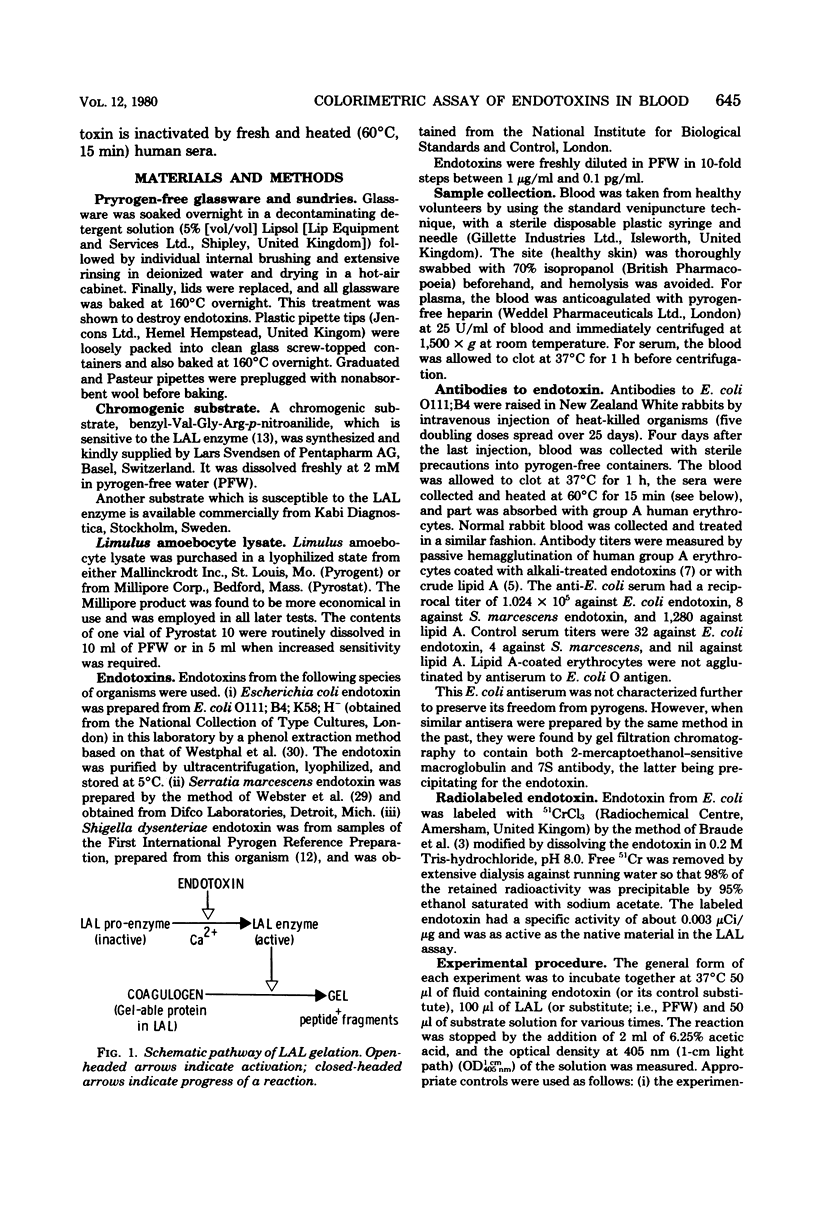
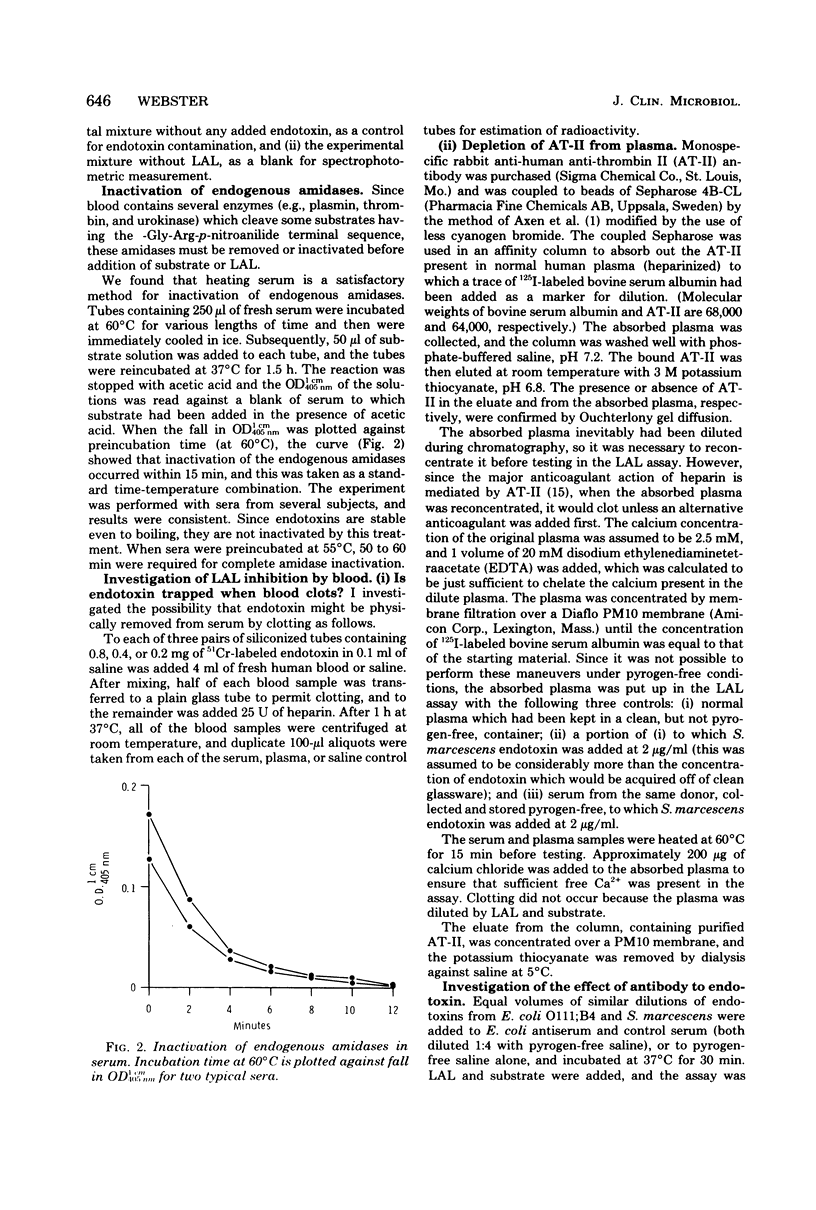
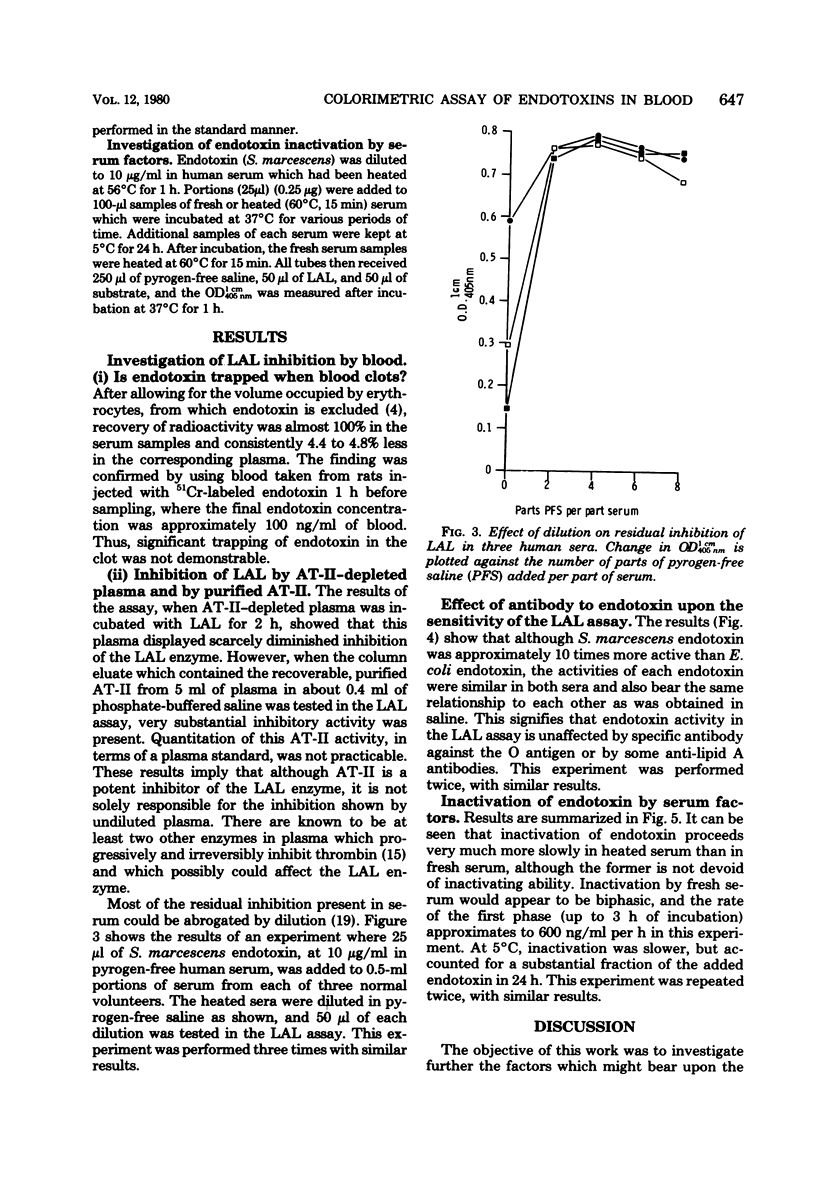
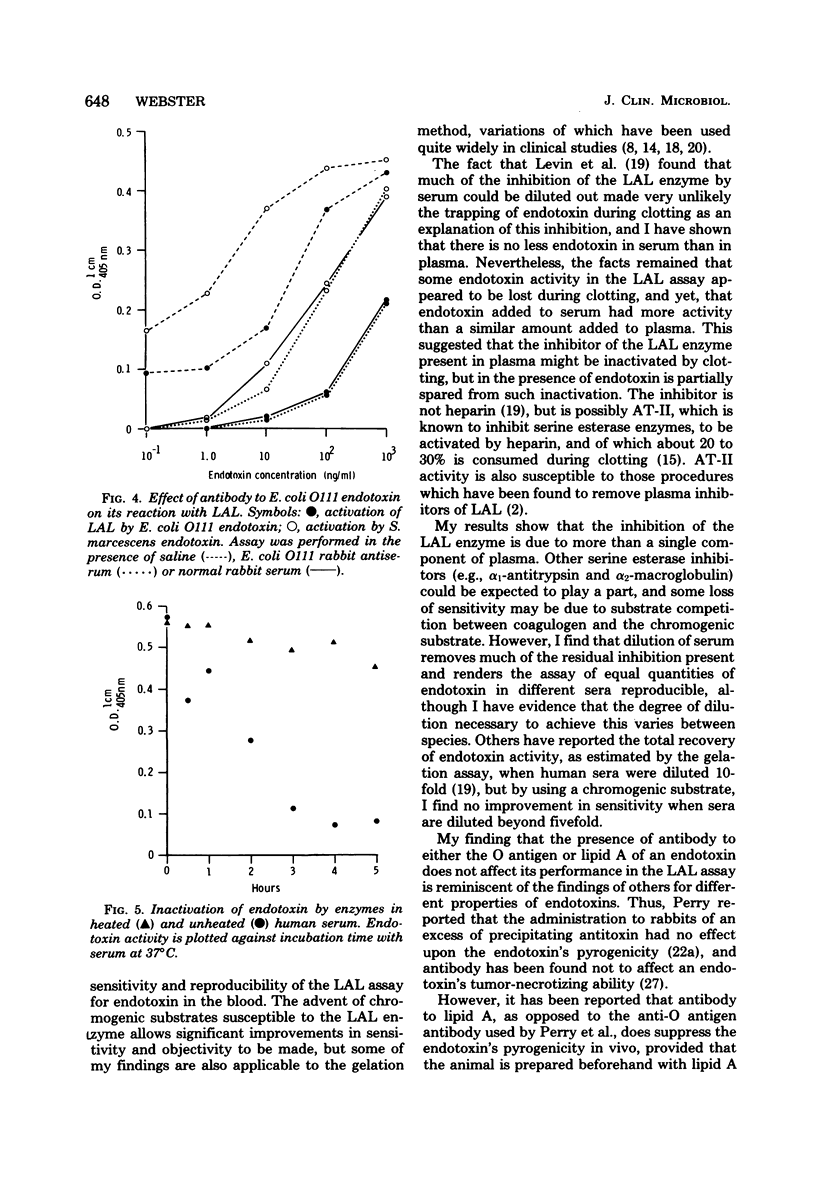
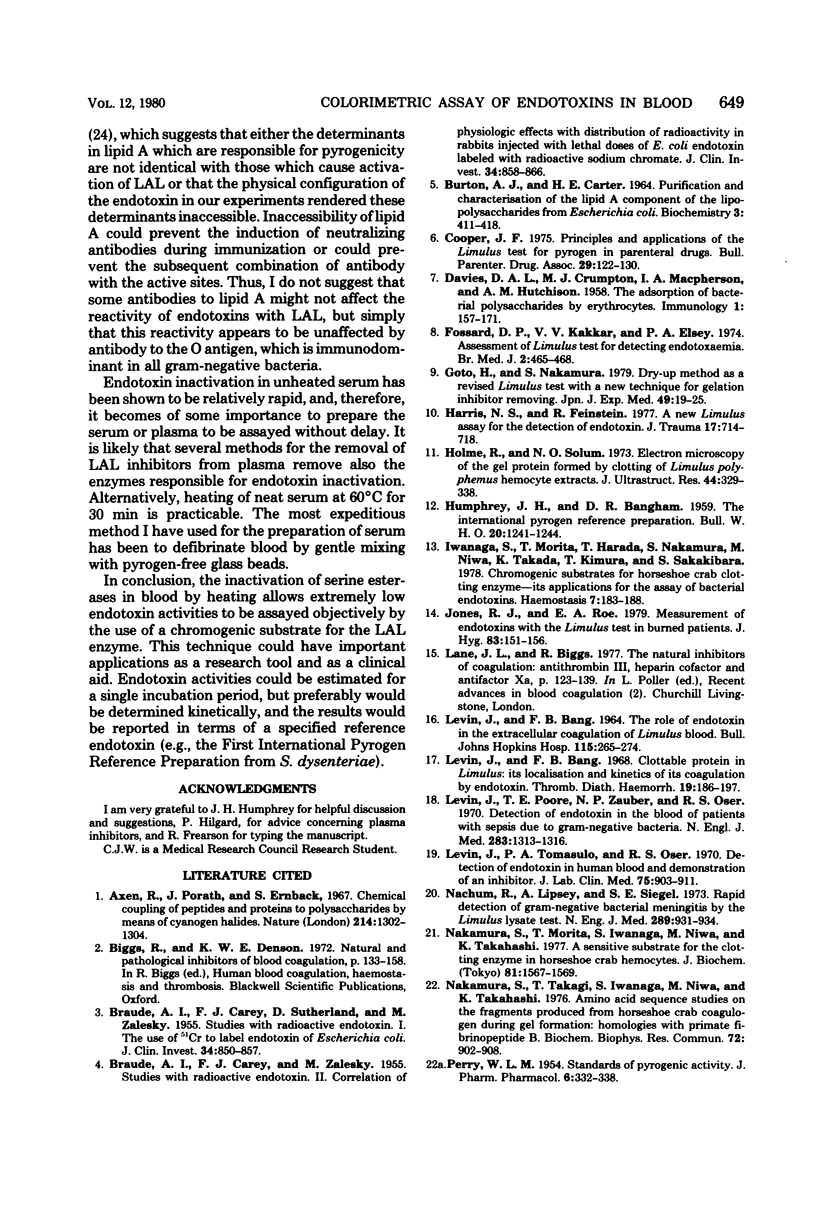
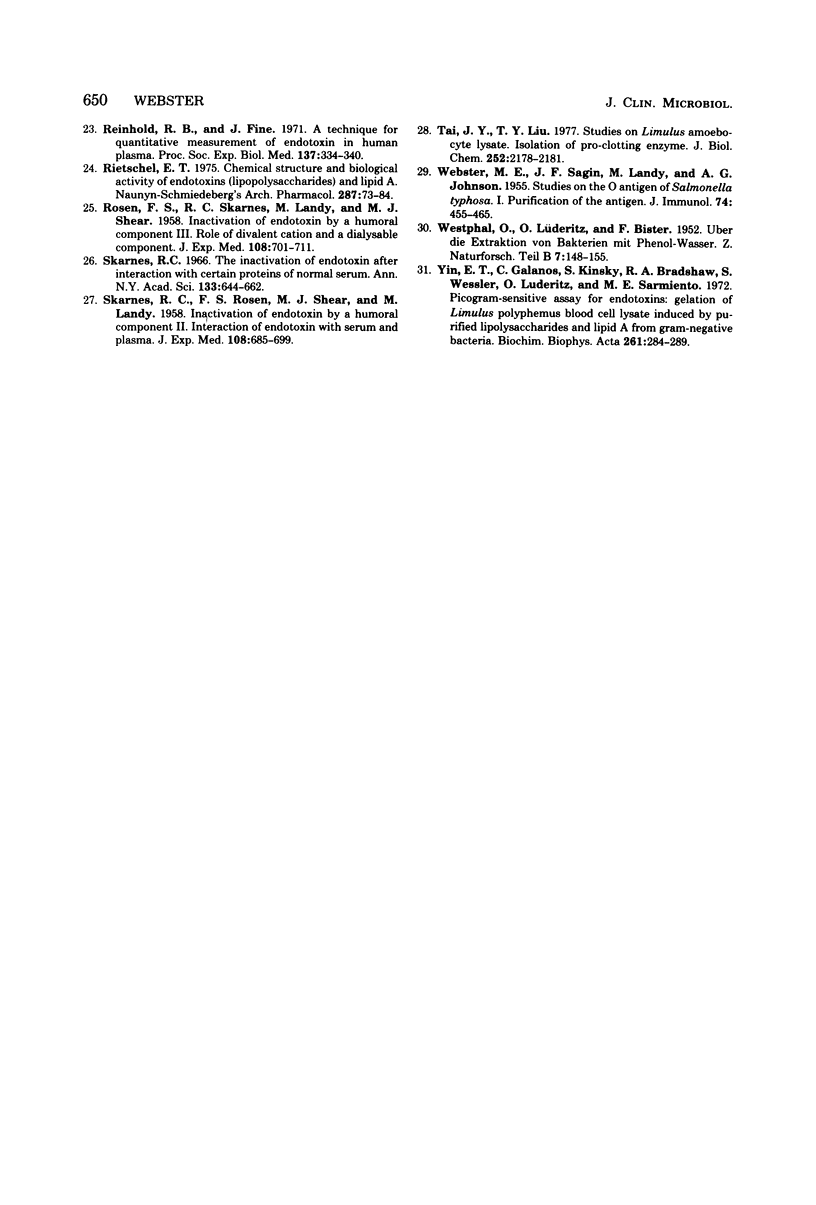
Selected References
These references are in PubMed. This may not be the complete list of references from this article.
- Axén R., Porath J., Ernback S. Chemical coupling of peptides and proteins to polysaccharides by means of cyanogen halides. Nature. 1967 Jun 24;214(5095):1302–1304. doi: 10.1038/2141302a0. [DOI] [PubMed] [Google Scholar]
- BRAUDE A. I., CAREY F. J., SUTHERLAND D., ZALESKY M. Studies with radioactive endotoxin. I. The use of Cr51 to label endotoxin of Escherichia coli. J Clin Invest. 1955 Jun;34(6):850–857. doi: 10.1172/JCI103140. [DOI] [PMC free article] [PubMed] [Google Scholar]
- BRAUDE A. I., CAREY F. J., ZALESKY M. Studies with radioactive endotoxin. II. Correlation of physiologic effects with distribution of radioactivity in rabbits injected with radioactive sodium chromate. J Clin Invest. 1955 Jun;34(6):858–866. doi: 10.1172/JCI103141. [DOI] [PMC free article] [PubMed] [Google Scholar]
- BURTON A. J., CARTER H. E. PURIFICATION AND CHARACTERIZATION OF THE LIPID A COMPONENT OF THE LIPOPOLYSACCHARIDES FROM ESCHERICHIA COLI. Biochemistry. 1964 Mar;3:411–418. doi: 10.1021/bi00891a018. [DOI] [PubMed] [Google Scholar]
- Cooper J. F. Principles and applications of the limulus test for pyrogen in parenteral drugs. Bull Parenter Drug Assoc. 1975 May-Jun;29(3):122–130. [PubMed] [Google Scholar]
- DAVIES D. A., CRUMPTON M. J., MACPHERSON I. A., HUTCHISON A. M. The adsorption of bacterial polysaccharides by erythrocytes. Immunology. 1958 Apr;1(2):157–171. [PMC free article] [PubMed] [Google Scholar]
- Fossard D. P., Kakkar V. V., Elsey P. A. Assessment of limulus test for detecting endotoxaemia. Br Med J. 1974 Jun 1;2(5917):465–468. doi: 10.1136/bmj.2.5917.465. [DOI] [PMC free article] [PubMed] [Google Scholar]
- Goto H., Nakamura S. Dry up method as a revised Limulus test with a new technique for gelatin inhibitor removing. Jpn J Exp Med. 1979 Feb;49(1):19–25. [PubMed] [Google Scholar]
- HUMPHREY J. H., BANGHAM D. R. The international pyrogen reference preparation. Bull World Health Organ. 1959;20:1241–1244. [PMC free article] [PubMed] [Google Scholar]
- Harris N. S., Feinstein R. A new limulus assay for the detection of endotoxin. J Trauma. 1977 Sep;17(9):714–718. doi: 10.1097/00005373-197709000-00008. [DOI] [PubMed] [Google Scholar]
- Holme R., Solum N. O. Electron microscopy of the gel protein formed by clotting of Limulus polyphemus hemocyte extracts. J Ultrastruct Res. 1973 Sep;44(5):329–338. doi: 10.1016/s0022-5320(73)90001-4. [DOI] [PubMed] [Google Scholar]
- Iwanaga S., Morita T., Harada T., Nakamura S., Niwa M., Takada K., Kimura T., Sakakibara S. Chromogenic substrates for horseshoe crab clotting enzyme. Its application for the assay of bacterial endotoxins. Haemostasis. 1978;7(2-3):183–188. doi: 10.1159/000214260. [DOI] [PubMed] [Google Scholar]
- Jones R. J., Roe E. A. Measurement of endotoxins with the limulus test in burned patients. J Hyg (Lond) 1979 Aug;83(1):151–156. doi: 10.1017/s0022172400025924. [DOI] [PMC free article] [PubMed] [Google Scholar]
- LEVIN J., BANG F. B. THE ROLE OF ENDOTOXIN IN THE EXTRACELLULAR COAGULATION OF LIMULUS BLOOD. Bull Johns Hopkins Hosp. 1964 Sep;115:265–274. [PubMed] [Google Scholar]
- Levin J., Bang F. B. Clottable protein in Limulus; its localization and kinetics of its coagulation by endotoxin. Thromb Diath Haemorrh. 1968 Mar 31;19(1):186–197. [PubMed] [Google Scholar]
- Levin J., Poore T. E., Zauber N. P., Oser R. S. Detection of endotoxin in the blood of patients with sepsis due to gran-negative bacteria. N Engl J Med. 1970 Dec 10;283(24):1313–1316. doi: 10.1056/NEJM197012102832404. [DOI] [PubMed] [Google Scholar]
- Levin J., Tomasulo P. A., Oser R. S. Detection of endotoxin in human blood and demonstration of an inhibitor. J Lab Clin Med. 1970 Jun;75(6):903–911. [PubMed] [Google Scholar]
- Nachum R., Lipsey A., Siegel S. E. Rapid detection of gram-negative bacterial meningitis by the limulus lysate test. N Engl J Med. 1973 Nov 1;289(18):931–934. doi: 10.1056/NEJM197311012891801. [DOI] [PubMed] [Google Scholar]
- Nakamura S., Morita T., Iwanaga S., Niwa M., Takahashi K. A sensitive substrate for the clotting enzyme in horseshoe crab hemocytes. J Biochem. 1977 May;81(5):1567–1569. [PubMed] [Google Scholar]
- Nakamura S., Takagi T., Iwanaga S., Niwa M., Takahashi K. Amino acid sequence studies on the fragments produced from horseshoe crab coagulogen during gel formation: homologies with primate fibrinopeptide B. Biochem Biophys Res Commun. 1976 Oct 4;72(3):902–908. doi: 10.1016/s0006-291x(76)80217-3. [DOI] [PubMed] [Google Scholar]
- PERRY W. L. Standards of pyrogenic activity. J Pharm Pharmacol. 1954 May;6(5):332–338. doi: 10.1111/j.2042-7158.1954.tb10955.x. [DOI] [PubMed] [Google Scholar]
- ROSEN F. S., SKARNES R. C., LANDY M., SHEAR M. J. Inactivation of endotoxin by a humoral component. III. Role of divalent cation and a dialyzable component. J Exp Med. 1958 Nov 1;108(5):701–711. doi: 10.1084/jem.108.5.701. [DOI] [PMC free article] [PubMed] [Google Scholar]
- Reinhold R. B., Fine J. A technique for quantitative measurement of endotoxin in human plasma. Proc Soc Exp Biol Med. 1971 May;137(1):334–340. doi: 10.3181/00379727-137-35572. [DOI] [PubMed] [Google Scholar]
- Rietschel E. T. Chemical structure and biological activity of endotoxins (lipopolysaccharides) and lipid A. Naunyn Schmiedebergs Arch Pharmacol. 1975;287(1):73–84. doi: 10.1007/BF00632639. [DOI] [PubMed] [Google Scholar]
- SKARNES R. C., ROSEN F. S., SHEAR M. J., LANDY M. Inactivation of endotoxin by a humoral component. II. Interaction of endotoxin with serum and plasma. J Exp Med. 1958 Nov 1;108(5):685–699. doi: 10.1084/jem.108.5.685. [DOI] [PMC free article] [PubMed] [Google Scholar]
- Skarnes R. C. The inactivation of endotoxin after interaction with certain proteins of normal serum. Ann N Y Acad Sci. 1966 Jun 30;133(2):644–662. doi: 10.1111/j.1749-6632.1966.tb52395.x. [DOI] [PubMed] [Google Scholar]
- Tai J. Y., Liu T. Y. Studies on Limulus amoebocyte lysate. Isolation of pro-clotting enzyme. J Biol Chem. 1977 Apr 10;252(7):2178–2181. [PubMed] [Google Scholar]
- WEBSTER M. E., SAGIN J. F., LANDY M., JOHNSON A. G. Studies on the O antigen of Salmonella typhosa. I. Purification of the antigen. J Immunol. 1955 Jun;74(6):455–465. [PubMed] [Google Scholar]
- Yin E. T., Galanos C., Kinsky S., Bradshaw R. A., Wessler S., Lüderitz O., Sarmiento M. E. Picogram-sensitive assay for endotoxin: gelation of Limulus polyphemus blood cell lysate induced by purified lipopolysaccharides and lipid A from Gram-negative bacteria. Biochim Biophys Acta. 1972 Jan 28;261(1):284–289. doi: 10.1016/0304-4165(72)90340-6. [DOI] [PubMed] [Google Scholar]


